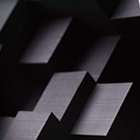C/C composite
C/C composite is a carbon-carbon composite material reinforced by high strength carbon fiber, which has superior properties such as light weight, high mechanical strength, and high elasticity. Because of their unique features, our C/C composites (CX series) are used in a wide range of fields such as electronics, environment and energy, general industrial furnaces, and automobiles and other means of transport.
C/C composite is a carbon-carbon composite material reinforced by high strength carbon fiber, which has superior properties such as light weight, high mechanical strength, and high elasticity. Because of their unique features, our C/C composites (CX series) are used in a wide range of fields such as electronics, environment and energy, general industrial furnaces, and automobiles and other means of transport.

Feature
C/C composite is a carbon-carbon composite material reinforced by high strength carbon fiber, which has superior properties such as light weight, high mechanical strength, and high elasticity. Because of their unique features, our C/C composites (CX series) are used in a wide range of fields such as electronics, environment and energy, general industrial furnaces, and automobiles and other means of transport.
Feature
High mechanical strength, high elasticity, and high toughness

C/C composites have higher strength, flexural resistance, and resistance to cracking and chipping, compared to isotropic graphite materials. C/C composites can be used with assurance, as the fractures do not propagate rapidly in them.

High Strength:
The strength is about 3 to 4 times that of isotropic graphite.
High Elasticity:
The modulus of elasticity is about 5 times that of isotropic graphite.
High Toughness:
No rapid progression of breakdowns.
Note : C/C composite is an anisotropic material and requires careful orientation.
Ultra heat resistance

C/C composites have higher strength at high temperatures compared to metallic materials. They can be used even at ultra-high temperatures of 2000℃ or higher in inert atmospheres.
Light- weight and easy to handle

C/C composites have low density compared to metallic materials and therefore, make light weight designing possible.
High thermal conductivity

A thermal conductivity higher than copper has been achieved (in CX-2002) through the use of carbon structure control technology, which involves our superior chemical vapor infiltration (CVI) treatment.
Product Inquiry
Inquiry form for C/C composite
Please wait a few seconds.
If the form does not appear after a few moments,Hereplease contact.

 YouTube Channel
YouTube Channel
 Carbon product FAQ
Carbon product FAQ
 Carbon ABC
Carbon ABC



